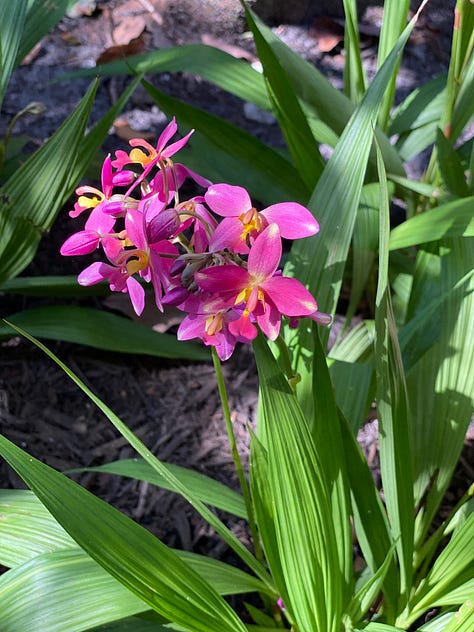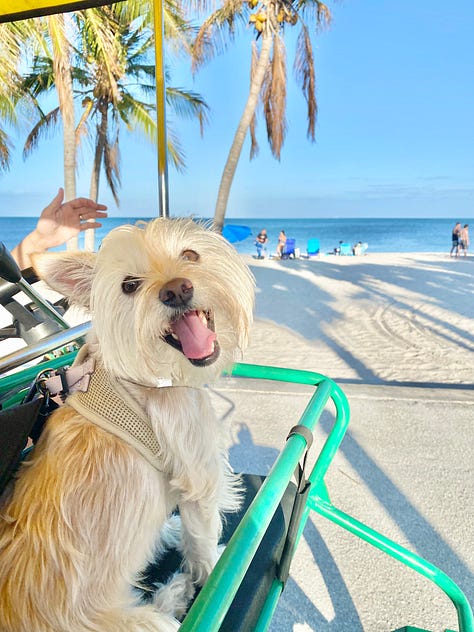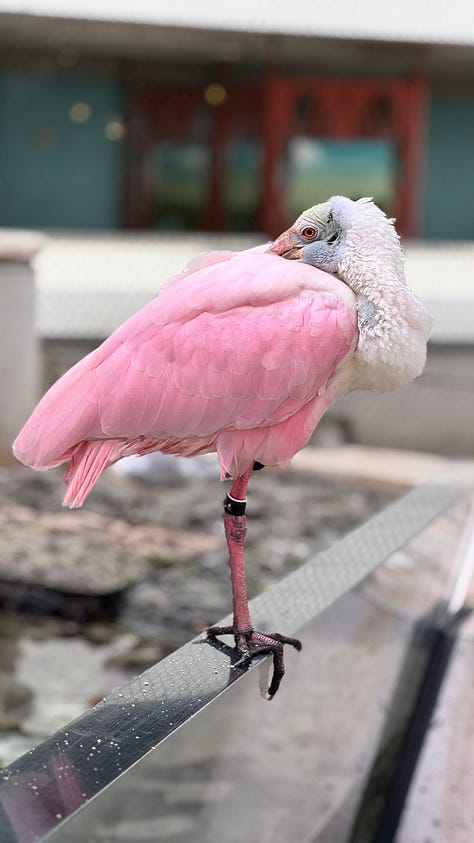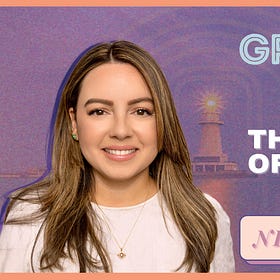The Grief of Uncertainty in Unprecedented Times
Finding your footing in a world that keeps shifting
Lately, I’ve been moving through the world with a hum of unease. Not the acute kind that arrives with a phone call or a diagnosis, but the steady thrum of not knowing. This disharmonious buzzing has been echoed and reflected back through conversations with podcast guests, colleagues, and grievers experiencing that same undercurrent of disquiet of existing in a moment that feels too much. “Unprecedented times,” as they say.
I’ve come to recognize this feeling as a variant form of good ol’ grief.
Grief for the world as it is.
Grief for the world as it was.
Grief for the changes we’re dealing with that seem completely unfair and preventable.
Grief for the world we hoped we’d get to grow old in.
And now, we are living in profoundly uncertain times. Maybe every generation says that, but this moment, with its overlapping crises and accelerated pace, feels particularly brittle.
(And let’s be honest… it’s the one we are living, which makes it the main point of reference from a lived-experience standpoint.)
We’re watching institutions unravel, and the dawn of the AI era. Trust feels elusive. The headlines toggle between absurd and apocalyptic: political instability, climate collapse, war, mass displacement, human rights abuses, and a relentless march of AI reshaping work and worth before we’ve even caught our breath.
You open social media and see, “we have some breaking news!” For once, you decide to close the app instead of letting cortisol-spiking updates making their way through the day’s news cycle hijack your day. So you check in with your friend, family, or random person who casually asks, “can you believe [insert latest ‘holy sh*t moment’]?!” And just like that, the buzzy-hum of unease gets a click or two louder, as uncertainty makes its way back to the front of the line. Sigh…
And beneath all of it, we are still grieving our own personal losses. The loved ones we’ll never hug again. The versions of ourselves that will never return. The futures we once planned for but had to release.
There’s a grief that comes when the world stops making sense.
Uncertainty Feels Like a Loss of Safety
When people think of grief, they often imagine the loss of someone. But grief expands far beyond death. It shows up in the cracks of our assumptions, in the collapse of what felt stable, in the sudden shift of what we thought we could count on. In realizing that the people we thought we knew and trusted increasingly feel like strangers.
Uncertainty is the loss of predictability. And predictability, whether we admit it or not, is one of the scaffolds of our mind and nervous system. It helps our minds make sense of the world and keep us “safe1” by having some educated guess through pattern recognition that it knows what tomorrow brings, therefore, it can be at ease (for now).
So when the scaffolding starts to fall away, our bodies respond, sometimes with anxiety, numbness, catastrophic thinking, and other times with a desperate attempt at controlling what little we can.
Our systems weren’t designed for this much change, this quickly. We’re living through what some grief theorists call living loss: an ongoing, ambiguous grief with no clear ending, no obituary to point to, no funeral or ritual to mark the shift.
This kind of grief lives in the liminal space where the old world is gone and the new one hasn’t arrived.
So other than soothing ourselves in the ways we’ve learned to survive, how else do we anchor ourselves in a reality where rapid, relentless change has become the new normal?
Slowing Down to Find Clarity
Uncertainty tricks us into believing we need to move faster. As if we just work harder, do more, know more, and stay alert… we’ll stay “safe”.
But speed doesn’t soothe grief. It often bypasses it.
If you’ve listened to earlier episodes of the Grief and Light podcast, you may have heard me say that grief is an invitation to slow down. It’s something I’ve had to live through time and time again. Not because slowing down is trendy or virtuous, but because it’s necessary. It’s how we begin to process what’s actually happening.
Slowing down allows us to go within, recalibrate, digest, feel, and return with more clarity.
I think of water in a glass looking cloudy until you let it sit still for long enough. The particles begin to settle. The water clears. You can finally see what’s actually in the vessel as well as through it.
When life is moving too fast, we lose sight of ourselves.
But when we slow down, we make space for clarity as we intentionally sift through the confusion to separate the fear, angst, and catastrophic thinking from the known facts.
My mom used to say, “Remember that fast is slow, and slow is fast.” I didn’t get it for some time (I probably rolled my eyes more than once). But after Yosef died, that phrase stopped being a riddle and started becoming a lived truth.
What I’ve come to understand is this: when we rush, we’re more prone to making mistakes. We miss the deeper messages. We gloss over the body’s signals. We have to circle back later to clean up what we skipped over. That’s the “fast is slow” part.
But when we slow down, intentionally and with presence, we’re able to move through things with more clarity and care. We integrate instead of avoid. We don’t waste energy pretending we’re okay when we’re not. That’s the “slow is fast.”
So consider this your invitation to slow down enough to name what you’re grieving in this moment.
What’s the quiet part that wants to be expressed out loud?
What am I grieving right now? If I’m being honest with myself, what feels the most unsettling in this moment?
What parts of me have been too quiet to hear over the noise?
Don’t overthink this. Actually, try not to think at all, but feel. Where in your body does it feel unsettling? Your belly? Shoulders? Tightness around your head?
Maybe just admitting to ourselves that, “This is hard. I don’t know what’s coming. And I miss what once was, and what will never be,” is enough.
How does it feel to say that out loud? Let me know in the comments.
Presence and honesty about what is helps ground us. And sometimes, that’s enough.
You may be interested in this episode ⤵️
The Liminality of Grief
This is the threshold of grief—we’re no longer the person we were before loss, and we haven’t yet discovered who we’re evolving into. So how can we stay true to ourselves as we get to know who we are becoming?
Finding our Anchor in Uncertain Times
So how do we live inside the not knowing without being consumed by it?
For me, it starts with remembering that grief isn’t something to overcome. Especially in uncertain times, when the losses are ambient, ongoing, and often unnamed, we need ways to anchor ourselves, not to avoid reality, but to meet it with more presence. Uncertainty is simply a part of life and our human condition.
Anchoring in uncertainty looks like returning to the body, to the next breath, to the small rituals that remind us we’re still here. That life is still still worth loving and living.
I’ve learned the importance of tending to grief not just when the waves crash, but also in the quieter moments. That means having a consistent practice I come back to, whether I’m spiraling or steady. The good times carry us through the hard times.
Growing the Grief and Light podcast, community, and social media has been my anchor. They remind me that I’m allowed to feel, and I don’t have to perform resilience to be okay. That the good times pass, so do the challenging ones. And that the only constant in life is change, so why not spend our energy learning to navigate it, rather than trying to control what we can’t?
Other, more private anchors look like slow mornings, nature walks, and sound bath meditations by the ocean.
(I know not everyone has access to oceanside rituals or quiet mornings. The invitation is to find your version of an anchor; whatever helps you feel rooted.)
There’s a difference between being informed and being inundated. So anchoring also means tuning out the noise.
In a world that profits off our panic, choosing to step away from the headlines isn’t avoidance, it’s nervous system care. And sometimes the most loving thing I can do is put down the phone and tune into what’s real: the sound of my dog’s paws on the floor, the feel of warm water over my hands, the laughter from someone I love.
When I notice my brain trying to convince me that everything is crumbling, I pause and collect evidence to the contrary. A stranger’s smile. A child’s joy. A woodpecker inspecting different trunks. These moments are not frivolous; they are data points that life is also beautiful, that wholeness and collapse can exist in the same breath.



As the cool kids say, “go touch grass”. (Figuratively and literally. Walk barefoot outside, and let your senses recalibrate. Let the earth remind you that you’re not floating away.)
And when it all still feels too much, I ask myself: What can I create meaning from, not just in spite of?
Sometimes the answer is community. Sometimes it’s creating art. Other times it’s being of service to others.
None of these are fixes. They’re footholds. They don’t solve the uncertainty, but they help us hold it with a steadier grip.
And that, too, helps us show up with presence and centeredness.
Anchored by Action
There are moments when the grief of uncertainty feels paralyzing, and then there are other times when the ache pushes us to act. Channeling the fear and grief of uncertainty into action is also a form of anchoring.
For some of us, action is what grounds us. It’s how we return to ourselves when the world feels untethered. Purposeful, values-aligned action can help transform anxiety into motion, and fear into focus.
But not all action is created equal. In uncertain times, the goal isn’t to do more or push harder; it’s to move intentionally, from a place of alignment rather than panic. Before rushing into activism, helping, or building something new, we can pause and ask:
How can I show up without depleting myself?
Do I have the capacity to show up from a place of abundance, not lack?
What are my strengths, and where do I feel most useful and resourced?
I recently revisited the work of Nora F. Murphy Johnson, PhD, and A. Rafael Johnson, who identify 21 distinct changemaker roles—ways people show up to contribute to a more just, inclusive, and resilient world. From Advocates and Healers to Pattern Spotters, Sustainers, Builders, and Bridgers, these roles remind us that we don’t all have to lead marches or speak on stages to be part of transformation.
Whether we care deeply behind the scenes, create spaces of warmth, or disrupt what no longer serves, we each hold a thread in this web of transformation.
Knowing your role doesn’t mean you’ll never feel overwhelmed again. But it does give you a framework in a shifting world without losing yourself in the process.
Action will look different for each of us. For example:
Maybe your anchor is in making art.
Maybe it’s in running for office.
Maybe it’s caring for your kids or your elders with intention.
Maybe it’s planting something in your garden.
Maybe it’s organizing mutual aid or mentoring someone one step behind you.
Maybe it’s helping local organizations with marketing.
Changing the world begins with one action that casts a powerful ripple effect. Sustained, intentional, heart-centered action creates endless ripple effects that move mountains.
In a time when everything feels uncertain, asking “What is mine to do?” and doing just that can be one of the most steadying things we offer ourselves, each other, and for humanity.
You’re Not Alone in This
To live in uncertain times is not just to survive chaos, it’s to remember that humans have always known how to adapt, how to grieve, how to rebuild in the dark.
You don’t have to be certain to be grounded. You don’t have to be fearless to be resilient. You don’t have to be okay to be worthy of love. But to see in the dark, we must find our light and trust it’s enough to guide the next step.
Uncertainty will always be a companion on the path of being alive. And grief, in all its wisdom, is simply trying to help us feel it so we don’t float away.
May you find your anchor one intentional moment at a time.
I’m with you, in the unknowing. With my resting grief face and my wide-open heart.
Nina Rodriguez is a Grief Guide, educator, podcaster, and speaker who helps people navigate grief with hope and agency. Following the unexpected loss of her only sibling, Yosef, she founded GRIEF AND LIGHT, a podcast and supportive online community to educate and empower individuals navigating loss and life-altering change. Through the podcast, grief circles, publications, collaborations, social media, Substack, and The Community, Nina aims to foster a more grief-informed, hopeful world. Learn more at: griefandlight.com.
Note on “safety”: Throughout this piece, I use the word “safe” in quotes to acknowledge that safety is not a one-size-fits-all experience. For some, it’s physical. For others, it’s emotional, relational, spiritual, or something else entirely. What feels safe to one person may feel destabilizing to another. Here, I use “safe” as a placeholder for a felt sense of grounding, steadiness, or internal refuge—knowing full well that this, too, is subjective and shaped by our histories, identities, and lived experiences.










Beautiful and that meme lol
Wow, beautiful article. It resonates so much with me. I feel the pain all over my body, but mainly in my gut. Definitely slowing down and taking one step at a time.